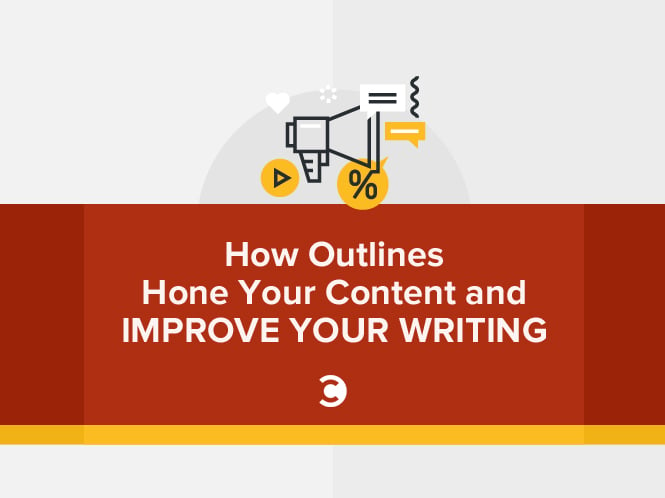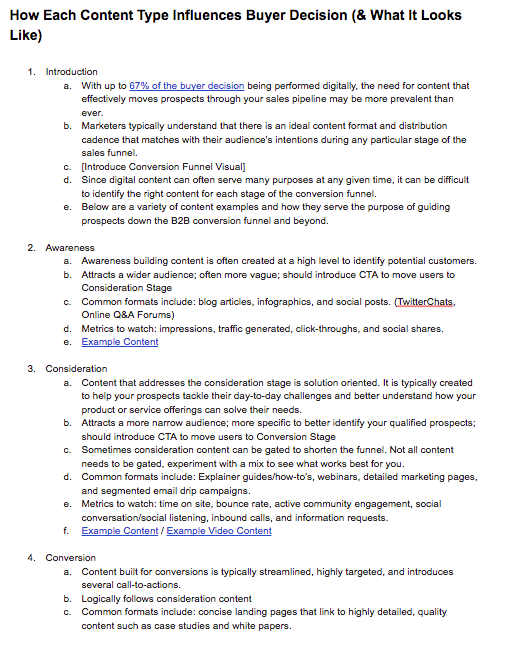
Copywriting comes naturally for some marketers—yet for many others, writing can feel like absolute torture. It’s no surprise, really. Writing succinctly and persuasively is an acquired skill that often requires endless hours of think-tanking, talking to oneself, brief moments of insatiable insanity, and a handful of untimely swear words. Meld the time it takes to write well with all of the competing pressures and tasks that a marketer juggles on a daily basis, and you have a recipe for frustration.
Learn how to create a strong outline to improve the direction of your content, open the door for team collaboration, and transform your writing into a more polished product that drives audience engagement and results for your marketing team.
Clarify Strategic Direction Before Executing Content
Whether creating ad copy, email nurture, landing pages, or an eighty-page ebook, knowing where to start and how your campaigns will affect your business goals is often a challenging guessing game. Too many marketers discover a strategic direction for their content efforts mid-way through a project, or it’s an afterthought entirely. It’s even common to approach content with a “get-er-done” attitude with intentions to save time, execute quickly, and test multiple variables; however, this mindset can lead to sloppy content execution and be an expensive lesson to learn.
This typically means poor content performance, misaligned brand messaging, or an underwhelming audience sentiment that could damage your marketing campaigns. The key to avoiding this is slowing down your content efforts, even if it’s just by an hour or two, to narrow your focus and strategic direction in an outline.
Creating an outline for your content can help both you and your team collaborate on the specific purpose of your content, the type of research or sources needed to support the content, and how the content can best align with your current marketing goals.
If you haven’t created an outline before, there are five fundamental steps.
Too many marketers discover a strategic direction for their content efforts mid-way through. Click To Tweet1. Decide on a Topic
Choose the topic and consider the general purpose of your content—such as where it will be published, how you plan to share it with your community, and how search engines will scan and rank your efforts.
It’s best to select a topic that is interesting to your audience, unique enough to earn attention, and serves the marketing themes within your customer journey. If you need help finding writing ideas, ask customers about nagging challenges that they have, study what your competitors create, and identify what influencers within your industry talk about. Jot down 10 to 20 ideas at a time to keep your plate full.
2. Brainstorm Your Talking Points
Develop a list of ideas that you should convey in your content. Treat this phase as a general brainstorm session and write down your thoughts, even if the connection to your topic is loose.
Write a few sentences or paste links to content that supports each of your ideas. These will serve as talking points or main discussion areas in your content. This is also an opportunity to be extensive and list possible ideas—even if your ideas seem off track, they may inspire future content efforts.

3. Organize Your Ideas
The next step is to organize your ideas so that your writing matches a logical flow and trim any ideas that are too far-fetched for your topic. This helps you create a structure that is easy to understand and helps your readers make sense of your content—which may also increase the likelihood of influencing user actions.
Keep in mind that in most landing page, ad copy, and email campaign scenarios, it’s best to identify one main point to help the reader simply convert without getting lost in copy. For longer form articles that range between 800 and 1500 words, you typically have room to clearly describe two to three points in depth.
[contextly_auto_sidebar]
4. Expand on Your Key Points
Hammer the details of your main ideas. In this step, quickly conduct supporting research. Fire up Google, find four or five relevant articles per idea, and paste the links in your outline. You don’t need to read all of the content yet—simply aim to get an idea of what content is being produced and what is performing well with search engines.
Take this process a step further by emailing colleagues or industry influencers to earn original examples, quotes, stories, or insight that can bolster your content.
5. Step Back to View the Big Picture
Finally, review your outline as a whole. Ensure that your topic is on theme, matches your editorial guidelines or brand tone, and matches the expectations of your marketing team. Make final structural adjustments, and share your outline with teammates for collaboration. Consider sharing your outline across departments to surface new ideas, keep leadership aware of your content pipeline, inform your design department of new work, or simply for general communication.
While the hour or so that it takes to create an outline seems like extra work, remember that it’s typically much faster to make changes to a drafted outline than mid-way through, or during the approval processes of content. This is particularly true when working with outside agencies or freelancers because sending content back for revisions can significantly increase production time, aggravate project managers, and make invoicing a nightmare.
Have you used outlines to hone the direction of your content writing? Do you create outlines for projects other than copywriting, such as design prompts or video projects? Have you ever required freelance writers or agency project managers to submit an outline or proposal before creating content? Share your experiences or any feedback that you may have below.
Get a weekly dose of the trends and insights you need to keep you ON top, from the strategy team at Convince & Convert. Sign up for the Convince & Convert ON email newsletter.

